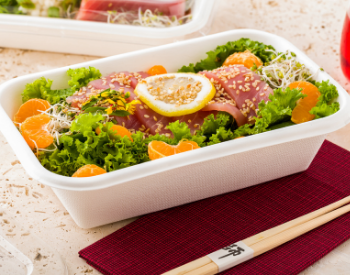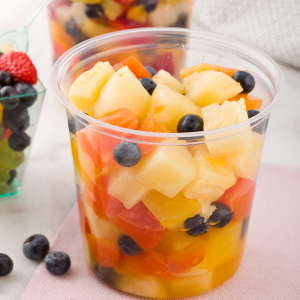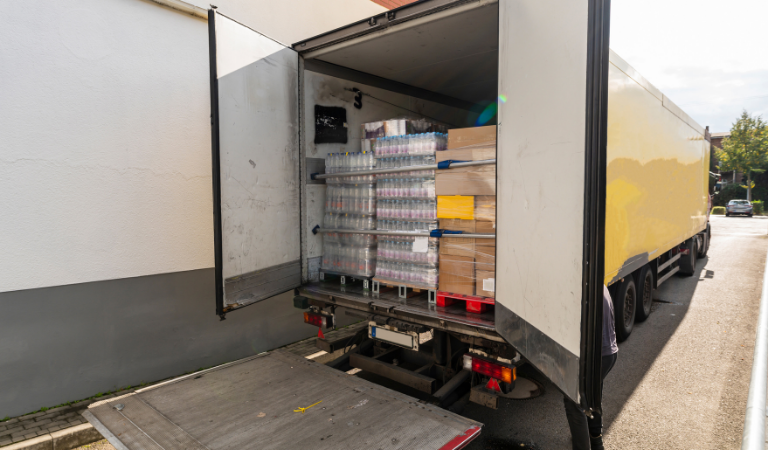Going green may sound like a daunting process because of the number of changes you’ll likely need to make at your foodservice establishment. However, upgrading your restaurant's day-to-day operations for more sustainable practices will reduce food waste and save your business money. It also allows you to attract and build connections with eco-conscious customers. We’ve created a detailed guide that provides you with 7 simple ways your business can reduce its impact on the environment.
1. Use Eco-Friendly Packaging
With the recent surge in take out and delivery orders, it’s important to find ways to bring sustainability to every order. The increased use of foam containers has harmful effects on the planet, and your customers are aware of the importance of reducing environmental damage. For instance, your business may offer customers the same type of food as a number of other local restaurants. However, eco-conscious patrons will only choose to order from your establishment if you use earth-friendly containers to package dishes. You can easily make your take out and delivery services eco-friendly by using to go boxes constructed from the following materials.
Bagasse/Sugarcane Packaging

Bagasse is a fibrous pulp that is left over after the extraction of juice from sugarcane. The pulp can be molded into different shapes and products, making it perfect for manufacturing to go containers. Bagasse products are commercially compostable and biodegradable and require little energy to be produced, providing you with an easy way to reduce your establishment’s carbon footprint. You can find bowls, plates, cups, and trays that are constructed from natural sugarcane fibers.
Benefits Of Bagasse/Sugarcane
- Commercially compostable and biodegradable
- Ideal for packaging hot or cold foods
- Grease-resistant
- Heat-resistant
- Microwave-safe
- Water-resistant
Wood Packaging
Wood is a naturally renewable energy resource that makes wooden take out boxes an excellent nature-friendly alternative to conventional to go containers. Wooden carry out boxes are naturally durable and built to contain hefty meals without bending or breaking. You can also find cutlery, plates, and bowls crafted from wood, allowing you to pair family meals with earth-friendly tableware.
Benefits Of Wood
- Commercially compostable and biodegradable
- Great for packaging hold or cold foods
- Grease-resistant
- Heat-resistant
- Water-resistant
PLA Packaging

Most plastics are derived from materials found in nature like gas, oil, coal, and other nonrenewable resources. However, polylactic acid (PLA) is a thermoplastic derived from renewable resources such as corn starch or sugarcane. Many restaurant owners love packaging orders in PLA containers because they carry similar characteristics as traditional plastic containers and are commercially compostable. You can also find cups, bowls, and flatware constructed from PLA.
Benefits Of PLA
- Commercially compostable and biodegradable
- Grease-resistant
- Water-resistant
Paper Packaging
You will find paper take out boxes in many eco-friendly establishments because they can be used to package a variety of foods and are made from renewable sources. Paper carry out boxes are available in a number of colors and patterns to bring a fun twist to take out orders. You can also purchase paper to go boxes that feature a grease-resistant lining which ensures that oily or saucy foods won’t seep through. In 9090/.,0ppenvironmentally-friendly restaurants, you will commonly see them pair delivery orders with disposable paper napkins, bags, cups, straws, food wraps, and more.
Benefits Of Unlined Paper
- Commercially compostable and biodegradable
- Ideal for packaging hot or cold foods
- Heat-resistant
Benefits Of Lined Paper
- Recyclable
- Excellent for packaging hot or cold foods
- Grease-resistant
- Heat-resistant
- Water-resistant
Bamboo Paper Packaging

In recent years, packaging made from bamboo paper has attracted the attention of many foodservice establishments. That’s because bamboo is one of the fastest-growing plants in the world and its underground stems help reduce soil erosion. Similar to disposable bamboo servingware, bamboo paper containers are grease-resistant and great for packaging hot or cold dishes. They are also naturally durable to maintain their exceptional design when filled with hefty foods and during delivery services.
Benefits Of Bamboo Paper
- Recyclable
- Great for packaging hold or cold foods
- Grease-resistant
- Water-resistant
2. Conserve Water
Every time a customer flushes the toilet or a staff member washes the dishes, water is being used. It’s important to find ways to conserve water at your foodservice establishment due to the limited supply of water on the planet. Using water efficiently also lowers the cost of your utility bills. Here are some eco-friendly restaurant ideas to conserve water:
- Only run the dishwasher when it’s full
- Serve customers water when they ask for it
- Check all of your restaurant’s pipes for leaks
- Replace traditional urinals with waterless urinals
- Place low-flow faucets in the kitchen and bathroom
- Use an in-house water filtration system to serve customers water
- Install water-efficient toilets to reduce the amount of water used with every flush
3. Choose Eco-Friendly Cleaning Products
When business owners are attempting to make eco-friendly changes at their restaurant, they tend to overlook cleaning products. This may be because they don’t realize that traditional cleaning products are made with harsh chemicals or aren’t aware of the earth-friendly options available on the market.
When reading the label of a cleaning product, look to see if the product contains a high amount of VOCs, fragrances, and flammable ingredients. These ingredients don’t easily break down and may cause customers to experience an allergic reaction or headache. Next time you’re placing an order for cleaning products, talk to your vendor and ask them about the eco-friendly alternatives they carry for the following products:
- Air fresheners
- Degreasers
- Detergents
- Disinfectants
- Dishwashing soaps
- Floor polishers
- Furniture polishers
- Fryer cleaners
- Glass cleaners
- Grill cleaners
- Hand soaps
- Ice machine cleaners
- Oven cleaners
- Stain removers
4. Invest In Energy-Efficient Equipment
Does your foodservice establishment spend a lot of money on electricity each month? That’s because the majority of equipment used to prep meals or wash dishes requires electricity. To cut down on energy usage, it’s essential to regularly do maintenance on your appliances. Machines that are properly working require less energy to operate than appliances that require maintenance.
If your restaurant is in need of new appliances, consider purchasing energy-efficient equipment. These appliances are built to use less energy which reduces your establishment’s energy consumption. You can also make these changes to help lower your energy usage and electric bill:
- Install low flush toilets
- Use energy-efficient light bulbs
- Switch to motion sensor lights
- Turn equipment off when not in use
- Open windows and turn off the air conditioner on cool days
5. Be Strategic About Shipments
Reducing the number of shipments you receive per week offers a simple way to cut down on fuel emissions. Distributors won’t need to drive to your establishment as often which allows them to reduce their carbon footprint.
When receiving fewer shipments per week, it’s important to restructure your ordering strategy. Create a plan that provides chefs with enough supplies and ingredients to prepare dishes until the next shipment. Keep track of inventory on a regular basis to ensure you don’t order too little or too many ingredients.

6. Reduce Food Waste
If you order too much food, don’t use portion control tools, or don’t properly store food, it’s more than likely that you’re throwing away large amounts of food. The food that is thrown away impacts your net profit and produces methane which is a major contributor to climate change.
To help minimize food waste at your foodservice establishment, it’s essential to find solutions. Below are a number of tips you can use to reduce the amount of food that’s being thrown away on a daily basis:
- Keep track of inventory: Using a POS system and tracking inventory by hand makes it easy to keep track of food waste and orders. You’ll know how much of each ingredient you have in stock to prevent you from over-ordering.
- Measure and weigh ingredients: Require cooks to use portion scoops, measuring cups, food scales, and other portion control tools when preparing dishes. These tools provide your staff with an easy way to prepare consistent portions and minimize food waste.
- Use the First In, First Out (FIFO) method: Implementing the FIFO method in your restaurant ensures that inventory is constantly rotated and older ingredients are used first. Practicing this method will reduce the amount of food that spoils in your kitchen.
-
Store food properly: After using ingredients, it’s vital to tightly seal and store
them in your freezer, fridge, or pantry. This will help prevent products from spoiling and provide
them with a longer shelf life.

7. Compost
Many eco-friendly restaurants compost organic waste on-site or through haul-away services. This keeps organic waste out of landfills and turns it into humus that can be used to fertilize crops. The humus eliminates the need to use chemical fertilizers that tend to damage plants and reduce crop yield. You can compost food scraps, coffee grounds, eggshells, or tea bags to reduce your waste and enrich the soil.
Time To Make Your Restaurant Sustainable
Finding ways to make your foodservice establishment more eco-friendly is beneficial for the environment. You’re able to reduce the amount of food that’s thrown away on a daily basis or package meals using earth-friendly containers to minimize your carbon footprint. These changes also benefit your wallet because you’re able to conserve water and use less energy throughout the day. With our 7 tips to make your business more eco-friendly, you’ll be able to capture the attention of eco-conscious customers and make a difference in the world.








